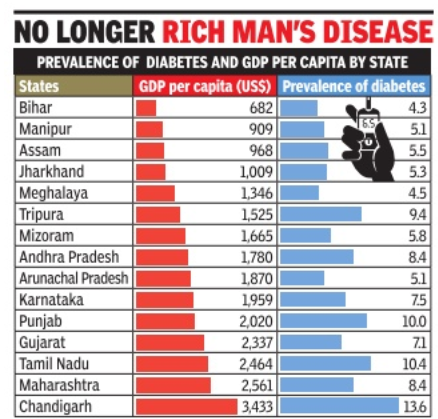Diabetes: India
(→A 2015 profile of Indian diabetics) |
(→2015-19: 12% of Indians above 50 had diabetes) |
||
| Line 121: | Line 121: | ||
Endocrinologist Dr Shashank Joshi from Lilavati Hospital said, “The level of 7% is the magic number endocrinologists seek for diabetics. But it can be relaxed in certain cases. In older people, doctors would be satisfied with 7.5% and 6.5% for pregnant women and youngsters.” The India Diabetes Care Index report said uncontrolled diabetes causes over 3 crore cases of complications of heart, eye, kidney, nerve and limb. The firm has started Impact India, a 1,000-day challenge to reduce India’s average HbA1c level by 1% by 2021. | Endocrinologist Dr Shashank Joshi from Lilavati Hospital said, “The level of 7% is the magic number endocrinologists seek for diabetics. But it can be relaxed in certain cases. In older people, doctors would be satisfied with 7.5% and 6.5% for pregnant women and youngsters.” The India Diabetes Care Index report said uncontrolled diabetes causes over 3 crore cases of complications of heart, eye, kidney, nerve and limb. The firm has started Impact India, a 1,000-day challenge to reduce India’s average HbA1c level by 1% by 2021. | ||
| − | |||
| − | |||
| − | |||
| − | + | [[Category:Health|D DIABETES: INDIADIABETES: INDIA | |
| − | + | DIABETES: INDIA]] | |
| − | + | [[Category:India|D DIABETES: INDIADIABETES: INDIA | |
| − | + | ||
| − | + | ||
| − | + | ||
| − | + | ||
| − | + | ||
| − | + | ||
| − | + | ||
| − | + | ||
| − | [[Category: | + | |
DIABETES: INDIA]] | DIABETES: INDIA]] | ||
| − | [[Category: | + | [[Category:Pages with broken file links|DIABETES: INDIA |
DIABETES: INDIA]] | DIABETES: INDIA]] | ||
| − | |||
Revision as of 19:21, 21 November 2022
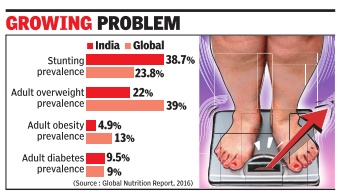
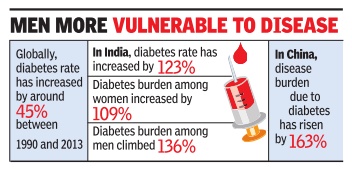
This is a collection of articles archived for the excellence of their content. |
Contents |
1990-2013
The Times of India, Jun 15 2015
Diabetes cases in India up 123% in 23 yrs
The number of diabetes cases in India has risen by 123% between 1990 and 2013, while globally , the increase was around 45%, a recent study has showed. The disease has also been identified among the 10 triggers for disorders ranging from obesity to paralytic strokes in both men and women, reports Sushmi Dey. The findings, part of a global study by the Institute for Health Metrics and Evaluation (IHME) at the University of Washington, is based on analysis of 301 acute and chronic diseases and injuries in 188 countries. Experts say the trend is linked to economic development of India over last two decades which has massively impacted lifestyle including eating and sleeping habits mainly among youngsters.
123% increase in India
The Times of India, Jun 15 2015, Sushmi Dey
India's diabetes rate up 123% since 1990
Diabetes has emerged as a major disease burden for India over the past two decades. While diabetes rate has increased by around 45% globally , it has jumped 123% in India between 1990 and 2013, a latest study has showed. Data shows diabetes is now among the top ten reasons for various other disorders among both men and women as it breeds obesity , obstructive sleep apnoea, severe kidney and lower urinary tract infection, stroke and many other diseases.
The findings are part of a global study conducted by the Institute for Health Metrics and Evaluation at the University of Washington.
The study , based on the analysis of 301 acute and chronic diseases and injuries in 188 countries, said the trend which has been more common in rich countries for several decades is now picking up in developing nations such as India, China and Mexico.
Maximum jump was observed in Type 2 diabetes, which is usually related to obesity and is the most common form of the disease.
Experts say the trend is linked to the economic development of India over last two decades which has massively impacted the lifestyle including the eating and sleeping habits among youngsters. “Diabetes is an escalating problem in India and has major socio-economic dimensions. Rapid dietary changes coupled with decreased level of physical activity have resulted in increasing obesity and diabetes in rural and semi-urban areas,“ said Dr Anoop Misra, a leading endocrinologist and chairman of Fortis-CDOC for diabetes and allied sciences.
According to Misra, increased stress level, irregular working hours, lack of exercise and consumption of alco hol and fast food were some of the significant contributors for the increasing incidence of diabetes in India.
Doctors say diabetes is a major cause of increasing disease burden among both men and women at an early age. For instance, more youngsters now face heart diseases, blood abnormalities, nerve damage, arthritis and other such disorders.
The study , however, shows a slight decline in deaths from communicable diseases like malaria and tuberculosis, while chronic diseases like cancer and diabetes are on the rise.
However, the burden of disability measured with population living with any given disorder in a year has not changed much over last two decades along with the causes remaining largely same on the list of top ten.
The top ranking diseases in India in both 1990 and 2013 include depressive disorder, iron deficiency anemia, low back pain, migraine. Diabetes, which did not feature among top ten diseases in India in 1990s, ranked eighth in 2013.
A 2015 profile of Indian diabetics
The Times of India, Nov 14 2015
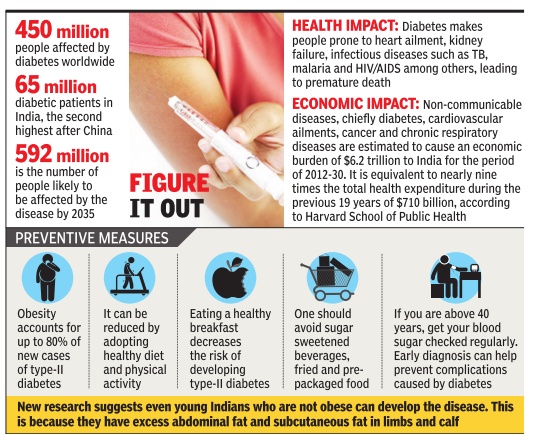
DurgeshNandan Jha
1 in 4 Indian diabetics not obese
It is not just the obese who develop diabetes.New research suggests that a number of Indian patients suffering from the disease are non-obese, having a body mass index (BMI) of less than 25 kgm2. They have high fat in the abdominal region, also referred to as central obesity besides fat in the liver and pancreas. According to Dr Anoop Misra, chairman of Fortis CDoc, nearly one out of every four diabetics in India are non-obese.
“Higher waist circumference, abdominal fat and depositions in the neck and chin area are some of the clinical symptoms to assess the risk factor. Such patients could be at higher risk for diabetes-related complications, for example heart attack, because of high fat in liver,“ he said.
The implications of this finding, which has been published in the recent issue of “PLOS One“ medical journal, are significant, said Dr Misra, adding that it could pave the way for a differential treatment module for nonobese patients.
Another study , published in “The Lancet“, has also fo und that apart from physical attributes, the genetic predisposition also adds to the risk of developing diabetes in Indians. “If we can find out the factors that influence these genes, the disease can be prevented,“ said Dr Sujeet Jha, one of the authors of the study funded by the European Union.
Dr Poonam Khetrapal Singh, WHO regional director for South-East Asia, said taking small steps like eating right, regular physical activity and maintaining a healthy weight can cut the risk of diabetes or delay its onset.
“The number of people with diabetes is projected to increase alarmingly from 457 million in 2014 to 592 million by 2035 if we do not act now to arrest this trend,“ she said.
Public health experts have warned about serious fi nancial implications from diabetes if India does not act fast to tackle the spread of the disease. At 65 million, India has the second highest number of diabetics in the world after China. Previously considered a disease of the affluent class, diabetes has spread fast among the rural poor too thanks to unhealthy diet and reduced physical activity.
Public Health Foundation of India, in a recent study, concluded non-communicab le diseases, chiefly diabetes or heart disease, affect the person in the productive years. “They cause reduced productivity and early retirement. Also, they put immense pressure on public health expenditure as in most cases the treatment costs are higher compared to communicable diseases,“ said a senior doctor at PHFI.
He said increasing bur den of non-communicable diseases could rob India of the “demographic dividend“ it is projected to reap on account of a predominantly young population. A report published by IRIS Knowledge Founda tion in collaboration with UN-HABITAT states that by 2020, India is set to become the world's youngest country with 64% of its population in the working age-group.
High per capita income high prevalence of diabetes
Sushmi Dey|Diabetes hits urban poor in rich cities|Jul 17 2017 : The Times of India (Delhi)
`Disease Now Becoming An Epidemic' Diabetes, often seen as a rich man's disease, is assuming epidemic proportions among the urban poor in “rich cities“ and is more prevalent in states with higher GDP , shows a recent study by the Indian Council of Medical Research (ICMR) across 15 states. The findings, published online in `The Lancet Diabetes and Endocrinology', said Chandigarh, which has the highest per capita annual GDP of $3,433, recorded the highest prevalence of diabetes at 13.6% while Bihar, with the lowest per capita GDP of $682, had the lowest prevalence at 4.3%.
In economically better off states like Punjab, Tamil Nadu, Andhra Pradesh, Maharashtra, Tripura and Manipur, and UTs like Chandigarh, diabetes is more common in rural areas than in urban areas. But in contrast to urban areas, diabetes was more common in individuals of higher socio-economic status in rural areas of all states.
“The spread of diabetes to economically disadvantaged sections of society is a matter of great concern, warranting urgent preventive measures,“ the study said.
In urban Chandigarh, diabetes among the lower socio-economic strata or poor people was as high as 26.9%, double the incidence (12.9%) for the well off. In Bihar, the trend was reversed with incidence among poor in urban areas only 4.7%, compa red to 5.4% among the rich.
Experts identify lifestyle as a major cause of increasing diabetes in affluent states. “Urban poor are usually migrants. They undergo a big change in diet and stress levels. Less healthy food and less exercise can be causes of diabetes,“ said Anoop Misra, chairman, Fortis C-DoC.
The overall prevalence of diabetes in the country was 7.3%, while 10.3% population in the pre-diabetic stage. The study was commissioned by the government.
1990-2018
Malathy Iyer, June 23, 2019: The Times of India
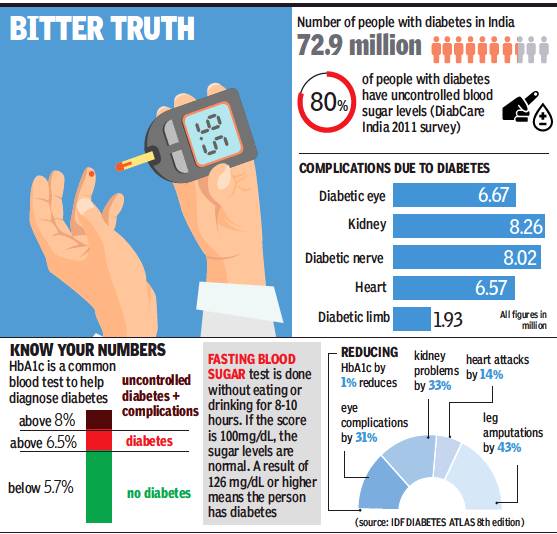
From: Malathy Iyer, June 23, 2019: The Times of India
Indians failing to control blood sugar levels: Study
‘Number Of Diabetics Among Poor Rising, Awareness A Casualty’
Mumbai:
India has the unfortunate moniker of ‘diabetes capital of the world’, yet there seems to be poor awareness across the country about the need to control fluctuating blood sugar levels.
The all-India levels of HbA1c, a blood test to determine the average blood sugar control levels over three months, stood at 8.5% in May 2019 — less than 6% is considered normal blood sugar levels (among nondiabetics), a new national survey has revealed.
The picture gets more dismal at the city level — from Mumbai to Kolkata and from Delhi to Chennai. Mumbai, the financial capital where people complain of high levels of stress and exhibit poor sleep patterns, has an average reading of 8.2% while the national capital of Delhi was worse at 8.8%.
The survey, part of an ongoing year-long study by Novo Nordisk Education Foundation, looked at the readings of 1.8 lakh patients across 28 cities. Diabetes, which is a condition in which the body’s ability to process blood glucose is impaired, affects its metabolism and over the years affects major organs such as kidneys, eyes, the nervous system, among others.
The study also looked at how HbA1c levels changed over a year in 28 cities. Bengaluru saw a rise in HbA1c levels from 8.3% in June 2018 to 8.4% in May 2019. In Hyderabad, it has been more or less static (8.59% and 8.6%).
During a one-year period, HbA1c levels for diabetes in cities like Chennai (8.4% to 8.2%) and Kolkata (8.4% to 8.1%) registered a fall. In Gurgaon, the levels fell from 8.6% to 8.5%. Smaller cities like Khandwa showed 9% in June 2018 and 8.2% in May 2019.
“The number of patients with diabetes in India is now increasing in the low socioeconomic strata. They are not well aware of the significance of the condition and how to control it. The result is a high average sugar levels and complications at an early age,’’ said Dr Anoop Misra. The survey is a part of pharmaceutical firm Novo Nordisk India’s recent India Diabetes Care Index report that maps diabetes and care. “The cost of diabetes care in India alone was estimated to be Rs 63,000 crore in 2017 with 72.9 million people in India being impacted by diabetes and 80% not getting recommended treatment,” said the report.
Dr Ambrish Mithal, who heads endocrinology at Medanta, the Medicity in Gurgaon, said the diabetes epidemic is still growing. “Till a few years ago, diabetes was something that happened to people above 40 but now we increasingly see it in 20-year-olds.” He said 60% of bypass surgery patients in his hospital had diabetes as an underlying cause. “In many metros, 40% of those aged over 60 have diabetes.”
Endocrinologist Dr Shashank Joshi from Lilavati Hospital said, “The level of 7% is the magic number endocrinologists seek for diabetics. But it can be relaxed in certain cases. In older people, doctors would be satisfied with 7.5% and 6.5% for pregnant women and youngsters.” The India Diabetes Care Index report said uncontrolled diabetes causes over 3 crore cases of complications of heart, eye, kidney, nerve and limb. The firm has started Impact India, a 1,000-day challenge to reduce India’s average HbA1c level by 1% by 2021.
